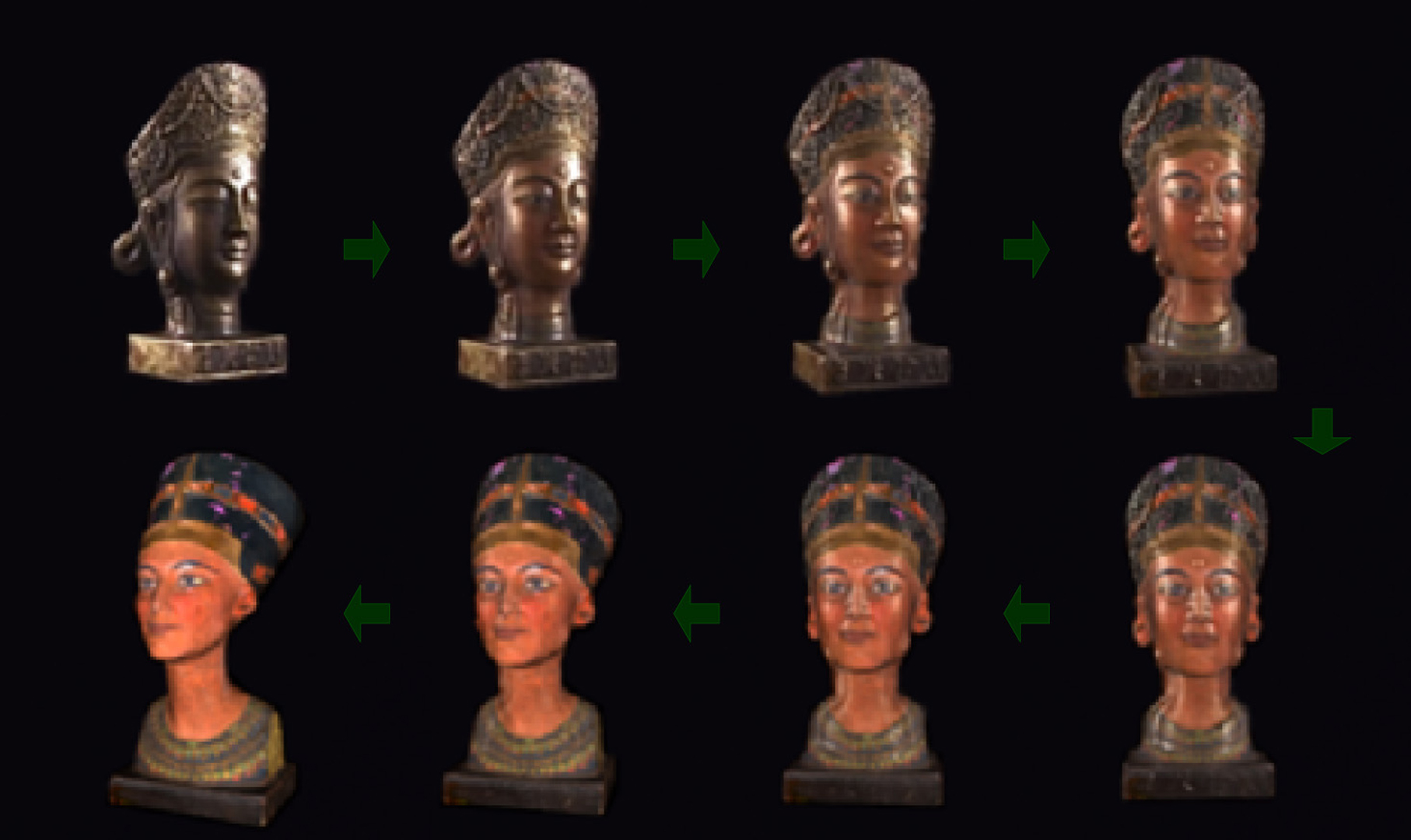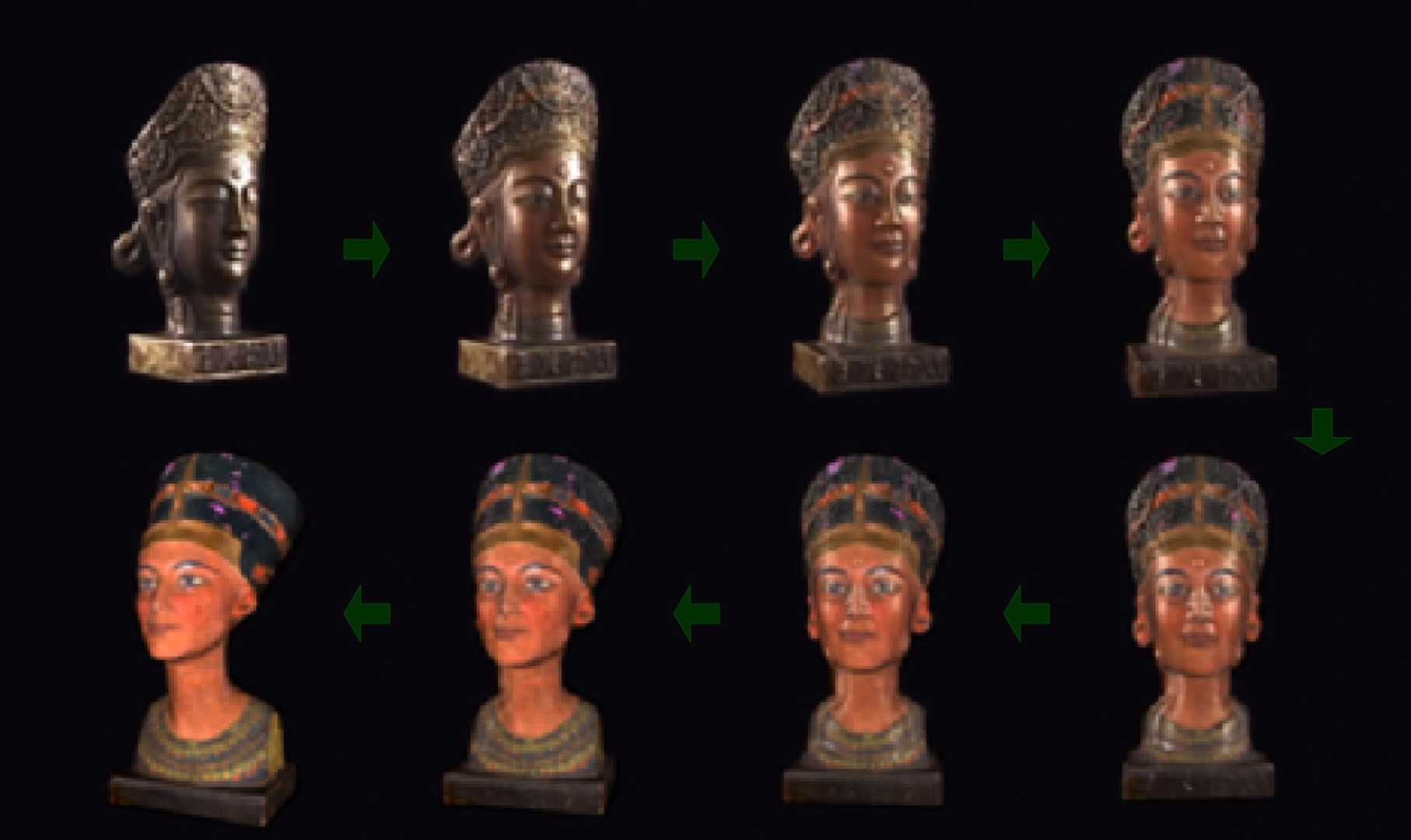“Feature-based light field morphing” by Zhang, Wang, Guo and
Conference:
Type(s):
Title:
- Feature-based light field morphing
Presenter(s)/Author(s):
Abstract:
We present a feature-based technique for morphing 3D objects represented by light fields. Our technique enables morphing of image-based objects whose geometry and surface properties are too difficult to model with traditional vision and graphics techniques. Light field morphing is not based on 3D reconstruction; instead it relies on ray correspondence, i.e., the correspondence between rays of the source and target light fields. We address two main issues in light field morphing: feature specification and visibility changes. For feature specification, we develop an intuitive and easy-to-use user interface (UI). The key to this UI is feature polygons, which are intuitively specified as 3D polygons and are used as a control mechanism for ray correspondence in the abstract 4D ray space. For handling visibility changes due to object shape changes, we introduce ray-space warping. Ray-space warping can fill arbitrarily large holes caused by object shape changes; these holes are usually too large to be properly handled by traditional image warping. Our method can deal with non-Lambertian surfaces, including specular surfaces (with dense light fields). We demonstrate that light field morphing is an effective and easy-to-use technqiue that can generate convincing 3D morphing effects.
References:
1. Thaddeus Beier and Shawn Neely. Feature-based image metamorphosis. Computer Graphics (Proceedings of SIGGRAPH 92), 26(2):35-42, July 1992. Google Scholar
2. Bryan P. Bergeron. Morphing as a means of generating variability in visual medical teaching materials. Computers in Biology and Medicine, 24:11-18, January 1994.Google Scholar
3. Chris Buehler, Michael Bosse, Leonard McMillan, Steven J. Gortler, and Michael F. Cohen. Unstructured lumigraph rendering. Proceedings of SIGGRAPH 2001, pages 425-432, August 2001. Google Scholar
4. Shenchang Eric Chen and Lance Williams. View interpolation for image synthesis. Proceedings of SIGGRAPH 93, pages 279-288, August 1993. Google Scholar
5. Daniel Cohen-Or, Amira Solomovici, and David Levin. Three-dimensional distance field metamorphosis. ACM Transactions on Graphics, 17(2):116-141, April 1998. ISSN 0730-0301. Google Scholar
6. Douglas DeCarlo and Jean Gallier. Topological evolution of surfaces. Graphics Interface ’96, pages 194-203, May 1996. Google Scholar
7. Julie Dorsey and Pat Hanrahan. Modeling and rendering of metallic patinas. Proceedings of SIGGRAPH 96, pages 387-396, August 1996. Google Scholar
8. Alexei A. Efros and William T. Freeman. Image quilting for texture synthesis and transfer. Proceedings of SIGGRAPH 2001, pages 341-346, August 2001. Google Scholar
9. Oliver Faugeras. 3D Computer Vision. The MIT Press, Cambridge, MA, 1993.Google Scholar
10. Jonas Gomes, Bruno Costa, Lucia Darsa, and Luiz Velho. Warping and Morphing of Graphics Objects. Morgan Kaufmann, 1998. Google Scholar
11. Steven J. Gortler, Radek Grzeszczuk, Richard Szeliski, and Michael F. Cohen. The lumigraph. Proceedings of SIGGRAPH 96, pages 43-54, August 1996. Google Scholar
12. Arthur Gregory, Andrei State, Ming C. Lin, Dinesh Manocha, and Mark A. Livingston. Interactive surface decomposition for polyhedral morphing. The Visual Computer, 15(9):453-470, 1999. Google Scholar
13. John F. Hughes. Scheduled fourier volume morphing. Computer Graphics (Proceedings of SIGGRAPH 92), 26(2):43-46, July 1992. Google Scholar
14. James R. Kent, Wayne E. Carlson, and Richard E. Parent. Shape transformation for polyhedral objects. Computer Graphics (Proceedings of SIGGRAPH 92), 26(2):47-54, July 1992. Google Scholar
15. Francis Lazarus and Anne Verroust. Three-dimensional metamorphosis: a survey. The Visual Computer, 14(8-9):373-389, 1998.Google Scholar
16. Aaron Lee, David Dobkin, Wim Sweldens, and Peter Schröder. Multiresolution mesh morphing. Proceedings of SIGGRAPH 99, pages 343-350, August 1999. Google Scholar
17. Apostolos Lerios, Chase D. Garfinkle, and Marc Levoy. Feature-based volume metamorphosis. Proceedings of SIGGRAPH 95, pages 449-456, August 1995. Google Scholar
18. Marc Levoy. Expanding the horizons of image-based modeling and rendering. In SIGGRAPH 97 Panel:Image-Based Rendering:Really New or Deja Vu, 1997. Google Scholar
19. Marc Levoy and Pat Hanrahan. Light field rendering. Proceedings of SIGGRAPH 96, pages 31-42, August 1996. Google Scholar
20. Wojciech Matusik, Chris Buehler, Ramesh Raskar, Steven J. Gortler, and Leonard McMillan. Image-based visual hulls. In Proceedings of ACM SIGGRAPH 2000, Computer Graphics Proceedings, Annual Conference Series, pages 369-374, July 2000. Google Scholar
21. Steven M. Seitz and Charles R. Dyer. View morphing: Synthesizing 3d metamorphoses using image transforms. Proceedings of SIGGRAPH 96, pages 21-30, August 1996. Google Scholar
22. Steven M. Seitz and Kiriakos N. Kutulakos. Plenoptic image editing. In ICCV98, pages 17-24, 1998. Google Scholar
23. Jonathan Shade, Steven J. Gortler, Li wei He, and Richard Szeliski. Layered depth images. In Proceedings of SIGGRAPH 98, Computer Graphics Proceedings, Annual Conference Series, pages 231-242, Orlando, Florida, July 1998. Google Scholar
24. Heung-Yeung Shum and Li-Wei He. Rendering with concentric mosaics. Proceedings of SIGGRAPH 99, pages 299-306, August 1999. ISBN 0-20148-560-5. Held in Los Angeles, California. Google Scholar
25. László Szirmay-Kalos and Werner Purgathofer. Global ray-bundle tracing with hardware acceleration. Eurographics Rendering Workshop 1998, pages 247-258, June 1998.Google Scholar
26. George Wolberg. Image morphing: a survey. The Visual Computer, 14(8-9):360-372, 1998.Google Scholar






